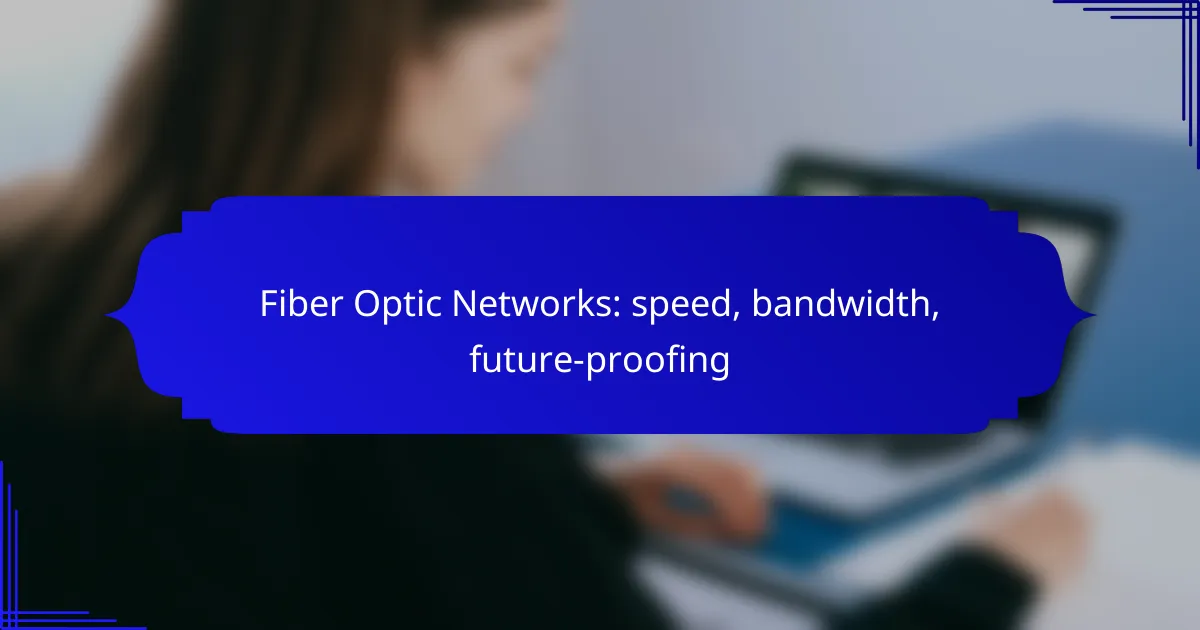Fiber optic networks provide unparalleled advantages in speed, bandwidth, and reliability, making them an essential choice for modern internet connectivity. As demand for high-speed services continues to grow, these networks not only meet current needs but also offer future-proof solutions for evolving technological landscapes.
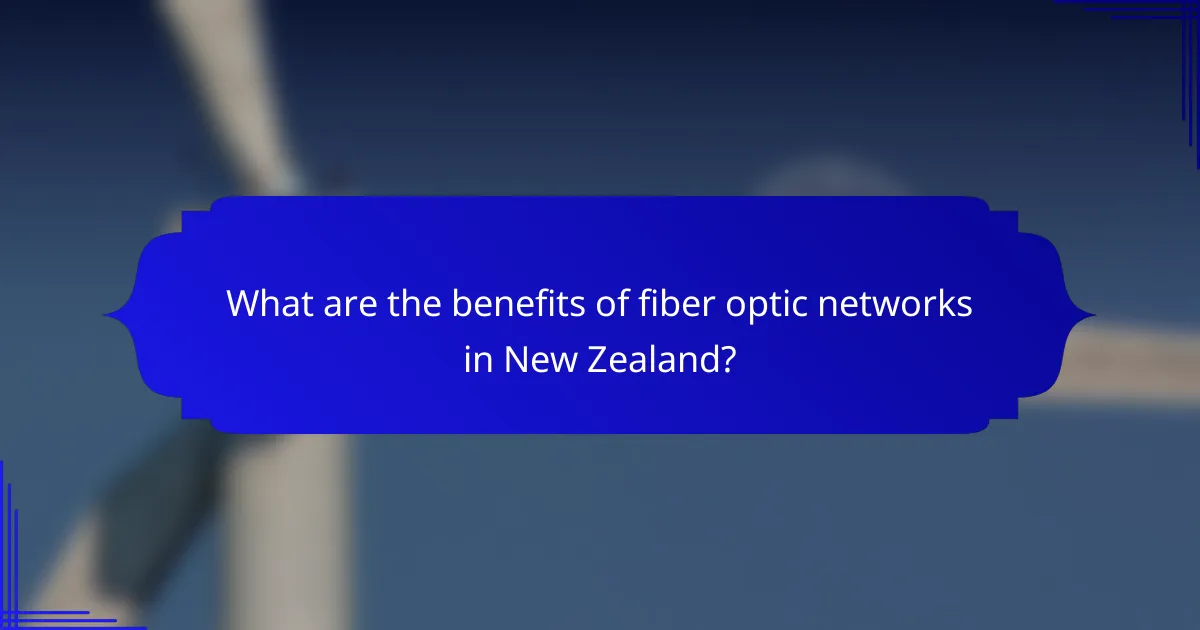
What are the benefits of fiber optic networks in New Zealand?
Fiber optic networks in New Zealand offer significant advantages, including high-speed internet access, increased bandwidth capacity, and future-proof technology. These benefits cater to the growing demand for reliable and fast internet services across the country.
High-speed internet access
Fiber optic technology enables internet speeds that can reach several gigabits per second, far surpassing traditional copper connections. This high-speed access is crucial for activities such as streaming, online gaming, and remote work, which require stable and fast connections.
In urban areas of New Zealand, many providers offer fiber plans that deliver speeds ranging from 100 Mbps to 1 Gbps. This allows households and businesses to enjoy seamless connectivity and improved productivity.
Increased bandwidth capacity
Fiber optic networks provide significantly higher bandwidth compared to older technologies. This increased capacity allows more users to connect simultaneously without experiencing slowdowns, making it ideal for densely populated regions.
For example, a single fiber connection can support multiple high-definition video streams, large file transfers, and numerous connected devices at once. This is particularly beneficial for families and businesses that rely on multiple devices for daily operations.
Future-proof technology
Investing in fiber optic infrastructure is a step towards future-proofing internet services in New Zealand. As technology evolves and data consumption increases, fiber networks can be upgraded to accommodate higher speeds and greater demands without needing extensive physical changes.
With the growing trend towards smart homes and IoT devices, having a robust fiber optic connection ensures that users can adapt to future technologies without facing limitations. This adaptability positions fiber networks as a long-term solution for reliable internet access.
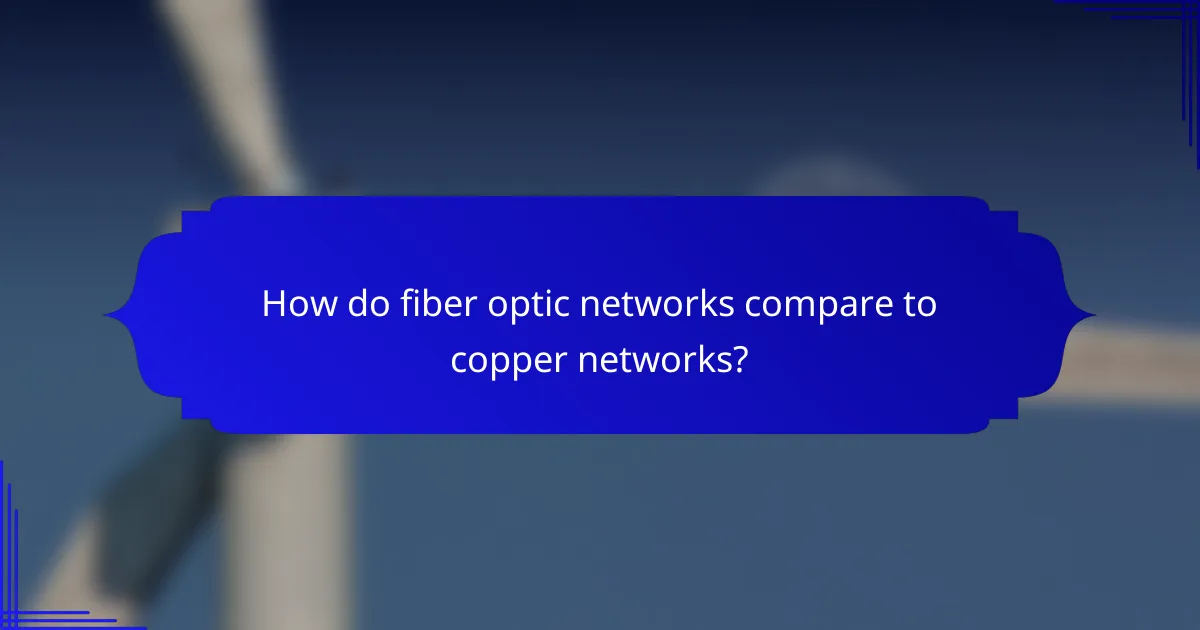
How do fiber optic networks compare to copper networks?
Fiber optic networks significantly outperform copper networks in terms of speed, bandwidth, and reliability. While copper can suffice for basic connectivity, fiber optics are essential for high-demand applications and future-proofing networks.
Faster data transmission
Fiber optic cables transmit data at the speed of light, allowing for much faster data transfer compared to copper cables. Typical fiber optic connections can achieve speeds ranging from hundreds of megabits per second to several gigabits per second, whereas copper often maxes out at lower speeds.
This speed advantage is crucial for applications requiring high bandwidth, such as streaming high-definition video or supporting multiple users simultaneously. For businesses, this translates to improved productivity and efficiency.
Lower signal degradation
Fiber optic networks experience significantly less signal degradation over distance compared to copper networks. While copper can lose signal strength over relatively short distances, fiber optics maintain their integrity over several kilometers without the need for repeaters.
This characteristic makes fiber optics ideal for long-distance communication, such as connecting different cities or regions. Users can expect consistent performance without the interruptions often associated with copper lines.
Greater distance coverage
Fiber optic cables can transmit data over much greater distances than copper cables without losing quality. Typically, fiber can cover distances of up to 100 kilometers or more without signal amplification, while copper is limited to around 100 meters for optimal performance.
This extended range is particularly beneficial for telecommunications and internet service providers who need to connect remote areas. Investing in fiber optics can reduce infrastructure costs and improve service availability in underserved regions.
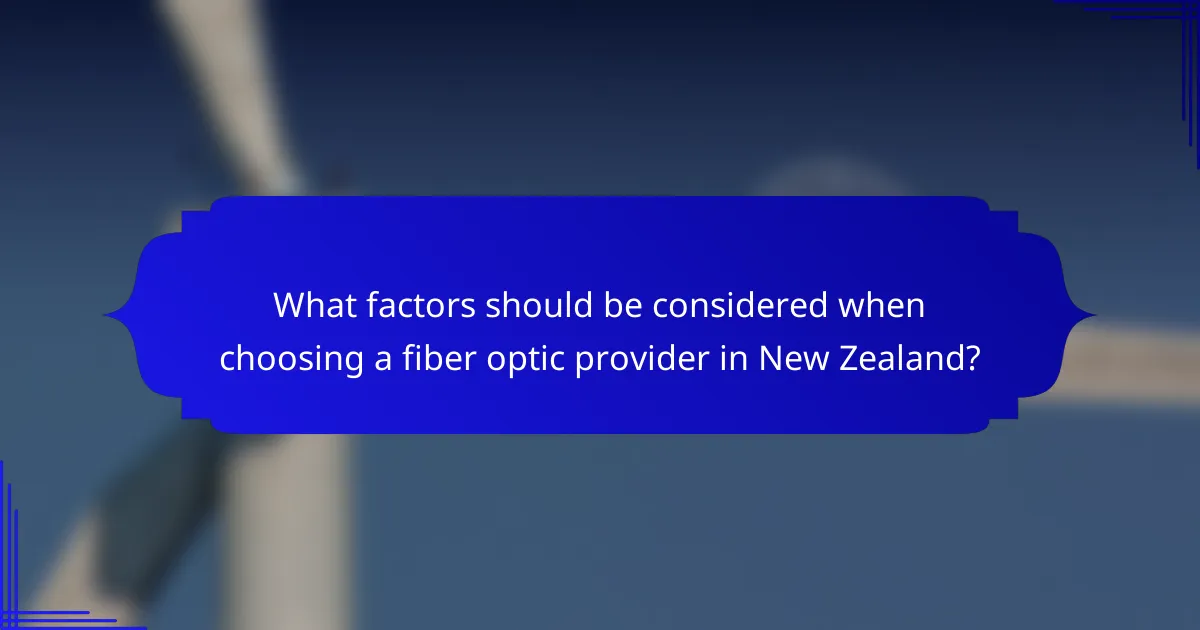
What factors should be considered when choosing a fiber optic provider in New Zealand?
When selecting a fiber optic provider in New Zealand, consider service reliability, pricing structures, and customer support quality. These factors significantly impact your overall experience and satisfaction with the service.
Service reliability
Service reliability refers to the consistency and uptime of the fiber optic network. A reliable provider should offer minimal downtime, ideally with Service Level Agreements (SLAs) that guarantee uptime percentages, often around 99.9% or higher.
Check for reviews and performance metrics from current customers to gauge reliability. Providers that have a strong track record in your area are often more dependable.
Pricing structures
Pricing structures can vary widely among fiber optic providers. Look for transparent pricing models that outline installation fees, monthly rates, and any additional costs for equipment or service upgrades.
Consider whether the provider offers bundled services, such as internet and phone, which can sometimes lead to savings. Always compare the total cost of ownership over time, not just the initial monthly rate.
Customer support quality
Customer support quality is crucial for resolving issues quickly and effectively. Evaluate the support options available, such as phone, email, or live chat, and their hours of operation.
Research customer reviews to understand the responsiveness and helpfulness of the support team. A provider with 24/7 support and a reputation for quick resolution times can save you significant hassle in the long run.
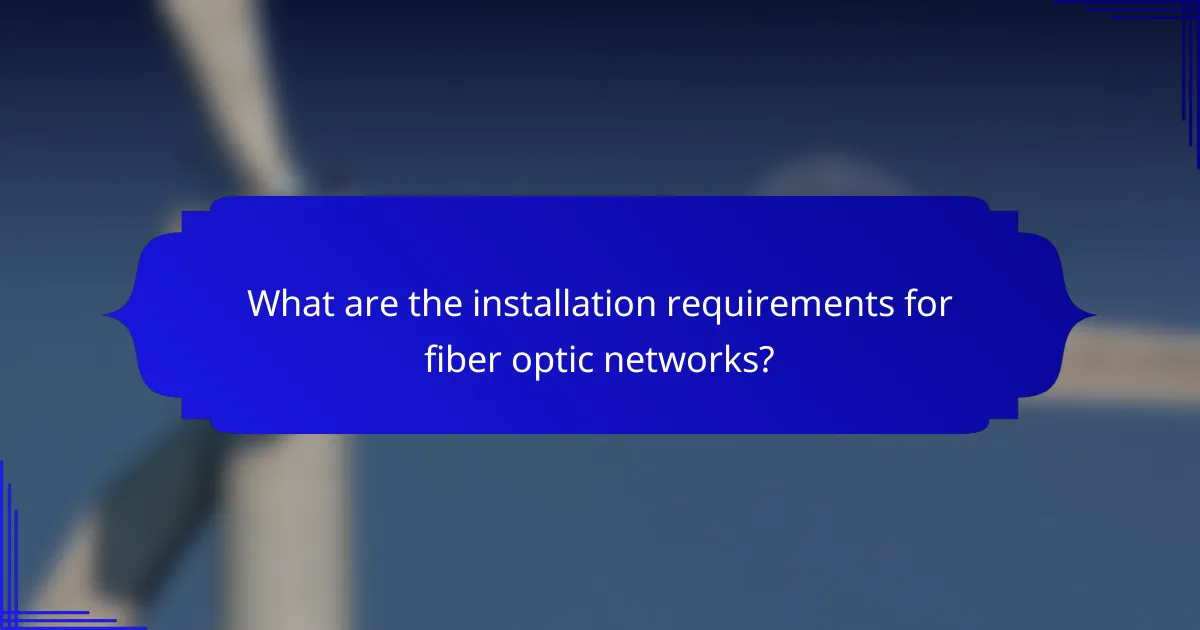
What are the installation requirements for fiber optic networks?
Installing fiber optic networks involves several key requirements, including site assessments, equipment specifications, and navigating permitting processes. Understanding these factors is crucial for successful deployment and optimal performance.
Site assessment
A thorough site assessment is essential before installing a fiber optic network. This process involves evaluating the physical environment, existing infrastructure, and potential obstacles such as trees, buildings, or underground utilities that may affect installation.
Consider conducting a survey to map out the proposed routes for fiber cables. Identifying the best pathways can minimize installation costs and time, ensuring a more efficient deployment.
Equipment specifications
Choosing the right equipment is critical for the performance of a fiber optic network. Key components include fiber cables, connectors, and transceivers, which must meet specific standards for compatibility and performance.
For instance, single-mode fibers are ideal for long-distance communication, while multimode fibers are suitable for shorter runs. Ensure that all equipment adheres to local regulations and industry standards to avoid future issues.
Permitting processes
Navigating the permitting processes is a vital step in fiber optic network installation. This may involve obtaining permissions from local authorities, utility companies, and property owners, depending on the installation location.
Start by researching local regulations and requirements, which can vary significantly by region. Allow ample time for this process, as it can take weeks or even months to secure all necessary permits, impacting project timelines.
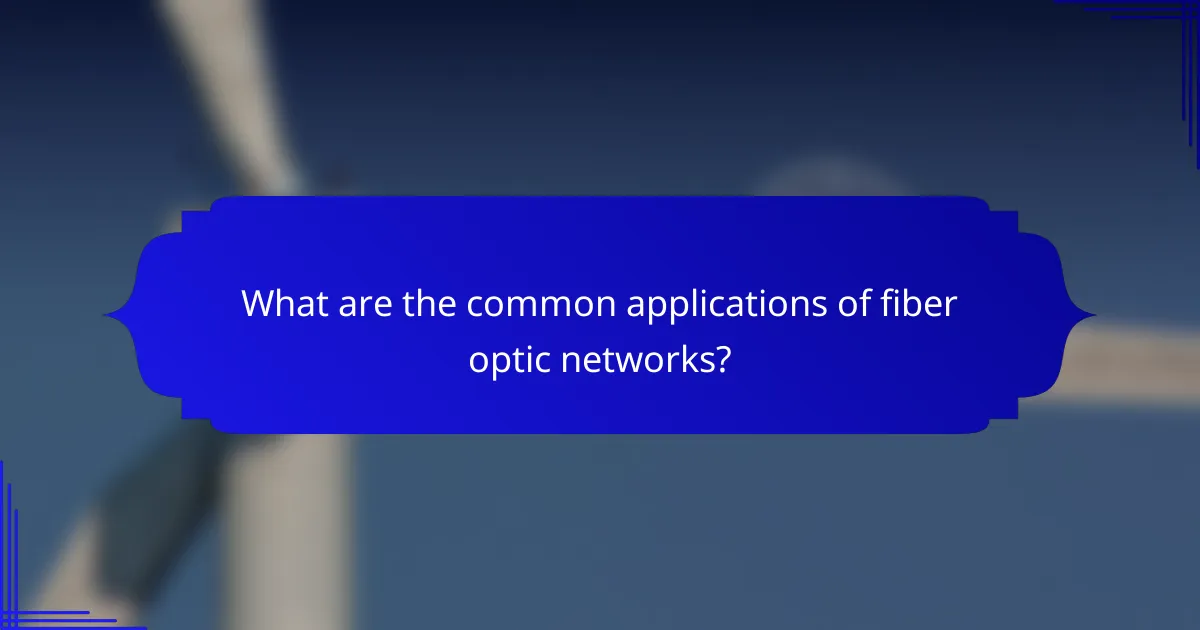
What are the common applications of fiber optic networks?
Fiber optic networks are widely used for high-speed data transmission across various sectors due to their superior bandwidth and reliability. Common applications include telecommunications, data centers, and smart city infrastructure, each benefiting from the enhanced performance that fiber optics provide.
Telecommunications
In telecommunications, fiber optic networks enable high-speed internet, television, and telephone services. They support vast amounts of data transfer, making them essential for both residential and commercial users. Providers often utilize fiber optics to deliver services that can reach gigabit speeds, significantly enhancing user experience.
When deploying fiber optics in telecommunications, consider factors such as installation costs, the existing infrastructure, and the potential for future upgrades. Fiber networks can be more expensive to install initially, but they offer lower maintenance costs and greater longevity compared to traditional copper lines.
Data centers
Data centers rely on fiber optic networks to connect servers and storage systems efficiently. The high bandwidth and low latency of fiber optics allow for rapid data transfer, which is crucial for cloud services and large-scale data processing. Many data centers use multi-mode and single-mode fibers depending on their specific needs.
When designing a data center network, prioritize scalability and redundancy. Fiber optics can support a range of distances and configurations, enabling data centers to expand their capabilities without significant overhauls. Regular assessments of bandwidth usage can help in planning for future growth.
Smart city infrastructure
Smart city infrastructure utilizes fiber optic networks to connect various systems, such as traffic management, public safety, and environmental monitoring. Fiber optics facilitate real-time data collection and analysis, which is essential for improving urban living conditions. This connectivity supports applications like smart traffic lights and surveillance systems.
For effective implementation, cities should focus on integrating fiber optics with existing technologies and ensuring robust cybersecurity measures. Collaborating with local governments and technology providers can enhance the development of smart city projects, ensuring they meet community needs while remaining secure and efficient.
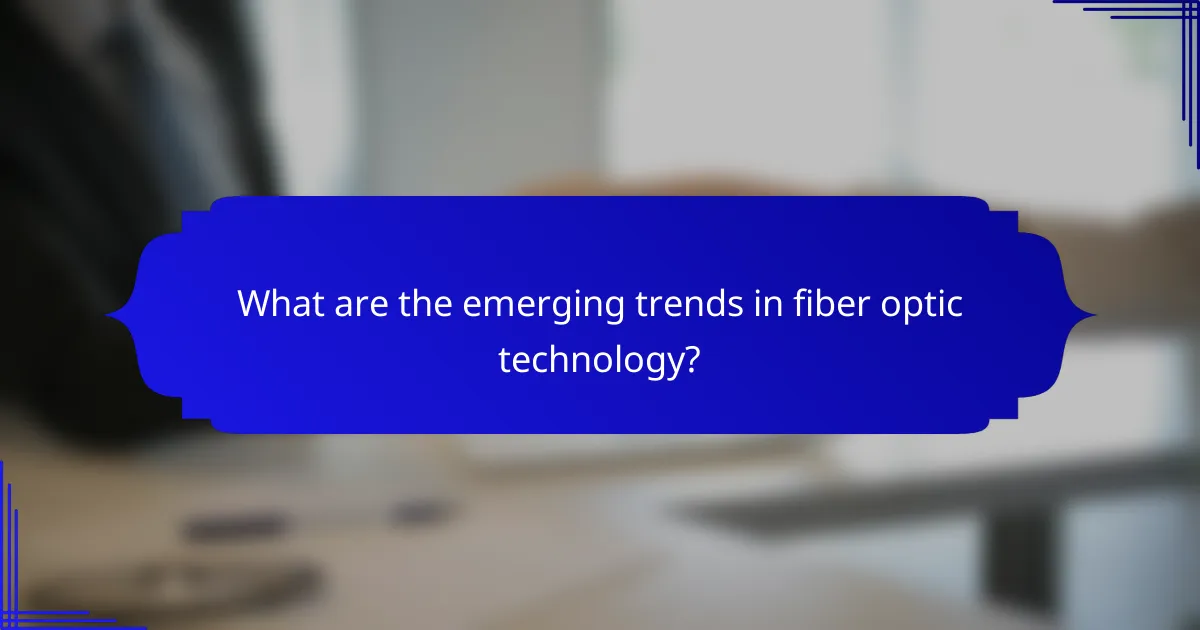
What are the emerging trends in fiber optic technology?
Emerging trends in fiber optic technology focus on enhancing speed, increasing bandwidth, and ensuring future-proofing for networks. Innovations in fiber types and integration with 5G networks are key areas driving these advancements.
Advancements in fiber types
Recent developments in fiber types include the introduction of multi-core fibers and photonic crystal fibers, which significantly boost data transmission capabilities. Multi-core fibers can carry multiple signals simultaneously, enhancing bandwidth without requiring additional infrastructure.
Another trend is the use of bend-insensitive fibers, which allow for tighter bends in installations without signal loss. This flexibility is crucial for urban environments where space is limited, making installations more efficient and cost-effective.
Integration with 5G networks
Fiber optic technology is essential for the rollout of 5G networks, providing the high-speed backbone necessary for data-intensive applications. The combination of fiber optics and 5G enables faster data rates and lower latency, which are critical for services like augmented reality and IoT devices.
As 5G networks expand, the demand for fiber optic connections to cell towers and small cells will increase. This integration ensures that network providers can meet the growing data demands of consumers and businesses, ultimately leading to improved connectivity and user experiences.
